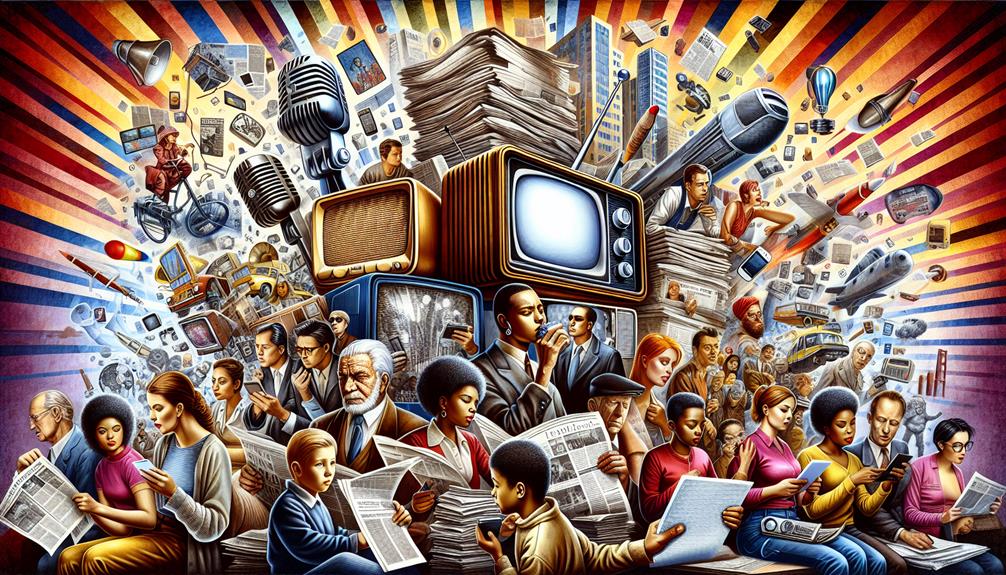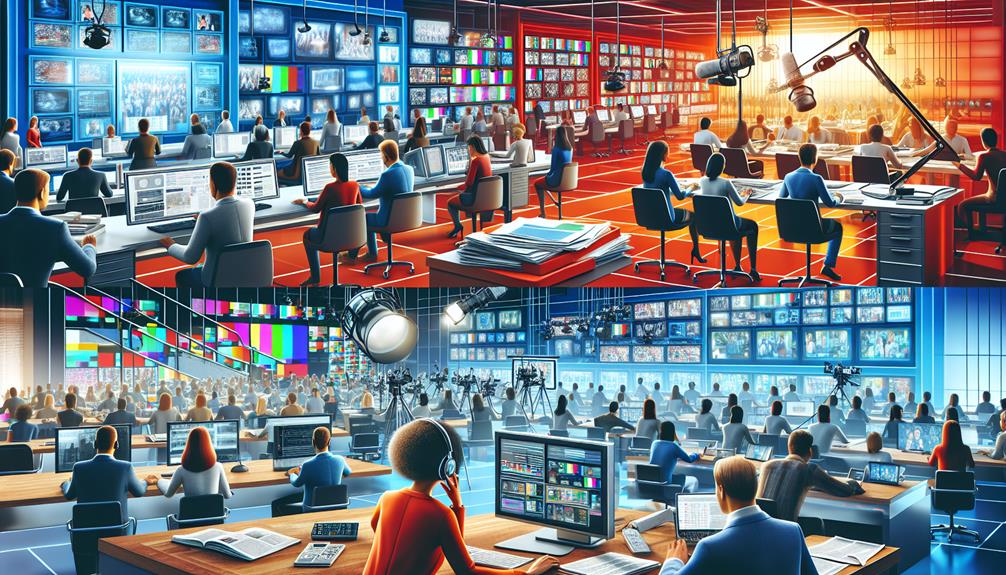When you think about media outlets, what comes to mind? You probably picture familiar names like CNN or The New York Times, but the landscape is much broader than that. Media outlets are vital channels for news and information, ranging from traditional newspapers to digital platforms. Each plays a distinct role in shaping how you perceive current events and trends. Yet, as technology evolves, so do the challenges these outlets face. What does this mean for the future of media and your access to information?
Understanding Media Outlets

Media outlets play a vital role in spreading information, adapting to various formats like digital, broadcast, and print.
You’ll find that understanding the different types of media outlets and how they’ve evolved is key to navigating today’s communication landscape.
This knowledge helps you connect with your audience more effectively and leverage the right platforms for your message.
Types of Media Outlets
Television, newspapers, radio, and online platforms each offer unique formats and audience engagement methods, catering to diverse preferences and information consumption habits. Television stations provide visual storytelling through news segments and documentaries, with many offering 24-hour news coverage to keep viewers informed.
Newspapers deliver in-depth articles and opinions, with various sections targeting different interests, while magazines in the world focus on niche topics and lifestyle content.
Radio stations continue to be relevant, offering traditional broadcasts and podcasts that delve into specific subjects, appealing to auditory learners. Public broadcasting, like NPR, emphasizes informative journalism, often relying on listener support and government funding.
Online news sites have revolutionized news media, allowing for instant access to breaking news and updates. Digital journalism thrives in this space, with platforms like HuffPost and CNN providing a mix of articles, videos, and interactive content. Mainstream news outlets leverage social media to reach wider audiences, enhancing engagement and dialogue.
Evolution of Media Outlets
The transformation of news outlets over the years has dramatically shifted from traditional formats to digital platforms, enhancing information accessibility for everyone. This evolution of media outlets has made it easier for you to access diverse news sources, from Fox News to smaller independent platforms. Traditional mass media, like newspapers and television, once dominated news coverage, but now you can receive breaking news instantly through your smartphone or computer.
Digital platforms have created top media outlets that cater to various audiences, allowing for a broader range of public opinion. The impact on information accessibility is significant; you’re no longer limited to the local newspaper or evening news. Instead, you can choose from countless online sources, blogs, and social media channels. This shift ensures that you have access to different perspectives and narratives.
Moreover, the rise of online news has transformed how stories are reported and consumed, enabling real-time updates and interactive content. As a result, you can engage with the news in ways that were previously unimaginable, shaping your understanding of current events and influencing public opinion more than ever before.
The Major Media Outlets

When you think about major media outlets, consider how broadcast giants like NBC and CBS shape public perception through their extensive reach.
At the same time, leading digital platforms such as Facebook and Twitter have transformed how news is consumed and shared.
Understanding both their influence and coverage scope is crucial for grasping the current media landscape.
Broadcast Media Giants
Major broadcast networks, like ABC, NBC, and CBS, dominate the media landscape, offering a diverse range of programming that caters to millions of viewers across the nation. These giants in broadcasting provide everything from daily news to entertainment and sports, ensuring they’re a staple in American households.
ABC News, for example, delivers in-depth reports and breaking news, while NBC focuses on a mix of hard-hitting journalism and lighthearted segments.
In the realm of cable TV, networks like CNN and Fox Business shape the conversation around politics and finance, appealing to specific audience demographics. NPR stands out for its commitment to informative journalism, offering listeners a deep dive into current events. Meanwhile, platforms like National Geographic engage audiences with captivating documentaries about nature and culture.
Digital outlets like BuzzFeed and HuffPost also play a crucial role, blending traditional news with engaging, shareable content. The Wall Street Journal remains a go-to for business news, reinforcing the importance of diverse media outlets in informing the public.
Together, these broadcast media giants shape the way you consume news and entertainment today.
Leading Digital Platforms
Digital-first media platforms consistently reshape how you consume news, adapting to the fast-paced demands of the online world. Leading digital platforms, such as news websites and social media outlets, have transformed the landscape of digital news consumption. With the rise of these platforms, traditional news organizations face the necessity for adaptation to digital formats, ensuring their relevance in a competitive environment.
You benefit from the immediacy and accessibility of online news, often receiving updates through various distribution channels. Social media outlets like Twitter and Facebook not only disseminate news but also foster media relationships, allowing you to interact with news organizations directly. This active engagement shapes your understanding of current events.
Additionally, digital-first media employs innovative strategies to attract audiences, such as personalized content and interactive features. These approaches enhance your consumption experience, making it easier to stay informed.
As you navigate this evolving news landscape, recognizing the impact of leading digital platforms on how you access information is crucial. Embracing these changes ensures you remain an informed consumer in a fast-evolving media ecosystem.
Function and Impact of Media Outlets

Media outlets play a crucial role in shaping public opinion by influencing what issues matter to you. Through agenda-setting, they determine the focus of national conversations and affect how you perceive both domestic and foreign events.
Understanding this impact helps you navigate the information landscape more effectively.
Agenda-Setting Role
Prioritizing news stories, outlets shape public discourse and influence what issues you consider important. Media outlets decide which stories to highlight, guiding your perception of what’s relevant. This agenda-setting role occurs through various distribution channels, including local news, American news, and national news channels.
| Media Outlet Type | Impact on Public Discourse |
|---|---|
| Newspapers | Provide in-depth feature stories that shape societal views |
| Television | Broadcast immediate news, influencing public reaction |
| Digital Media | Shares trending topics rapidly, creating real-time conversations |
| Social Media | Engages audiences directly, allowing for diverse opinions |
According to the Pew Research Center, the outlet you consume can significantly affect your understanding of current events. Each publication or broadcast uses its lens to frame stories, often prioritizing certain narratives over others. For example, an outlet based on sensationalism might emphasize drama, while others focus on informative journalism. Ultimately, these choices directly impact your engagement with public discourse, shaping the societal priorities you consider essential.
Media and Public Perception
Through targeted coverage and framing, news outlets actively shape your understanding of key societal issues and influence public perception. Media outlets are incredibly influential; they often determine which news stories gain traction and how societal views evolve.
This impact is especially evident during critical events, like elections or social movements, where media coverage can sway public opinion significantly.
Advertiser influence also plays a role, as brands may seek favorable coverage to enhance their image, creating a complex relationship between media and commerce.
Social media outlets further amplify this effect, allowing news stories to spread rapidly, often without verification. The pursuit of Pulitzer Prizes can drive outlets to produce high-quality journalism, but it can also lead to sensationalism that distorts the truth.
Challenges Facing Media Outlets

Media outlets today face significant challenges that impact their credibility and financial stability.
You’ll notice that regulatory and ethical considerations often clash with the rapid pace of technological change, making it tough for outlets to maintain trust.
As you explore these issues, consider how they influence the way media operates and the information you consume.
Regulatory and Ethical Considerations
Navigating the complex regulatory frameworks and ethical dilemmas presents significant challenges for media outlets today. These regulatory frameworks governing media often dictate how news websites can operate, ensuring they provide accurate and fair feature stories to the public. However, the balance between compliance and journalistic freedom can lead to ethical dilemmas in media.
For instance, media outlets may face pressure to prioritize sensationalism over factual reporting, creating conflicts between regulatory considerations and ethical obligations. Furthermore, the rise of digital platforms complicates these dynamics, as different regulations apply to various forms of news and media.
Ethical considerations, such as maintaining transparency and avoiding misinformation, become paramount in an age where audiences are increasingly skeptical. By addressing ethical dilemmas head-on, media outlets can foster trust and credibility. They must navigate these challenges while adhering to the standards set by regulatory bodies, which often seek to protect the public interest.
Ultimately, balancing regulatory frameworks and ethical responsibilities is crucial for media outlets striving to inform and engage their audiences effectively.
Technological Impacts on Media
Technological advancements have transformed how media outlets produce and distribute content, presenting both opportunities and challenges in the digital landscape. The rise of social media has significantly impacted media distribution, allowing you to share news instantly with a global audience. However, this shift also brings challenges, such as the spread of misinformation and the need for outlets to compete for attention in a crowded space.
Mobile journalism has emerged as a key player, enabling journalists to report on-the-go using smartphones and apps. This technology enhances media production quality and accessibility but requires reporters to adapt quickly to new tools. The effects of these advancements can be seen in how audiences consume news, often favoring bite-sized content over in-depth reporting.
As technology continues to evolve, media outlets must navigate the complexities of maintaining credibility while harnessing the benefits of rapid distribution and production. The impact of these technological advancements is profound, shaping not only how news is shared but also how the public engages with it. Ultimately, understanding these dynamics is crucial for media professionals aiming to thrive in this fast-paced environment.
Conclusion
In conclusion, media outlets are essential in shaping how you receive and interact with information. They come in various forms, each catering to different preferences and needs.
As you navigate through these platforms, it’s important to recognize their influence on public discourse and your perceptions. However, keep in mind the challenges they face, including misinformation and evolving technology.
By staying informed and critical, you can better engage with the media landscape and make sense of the world around you.


